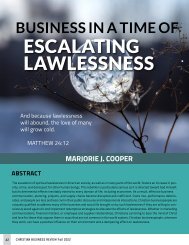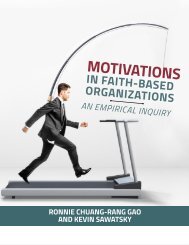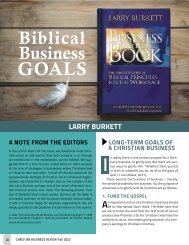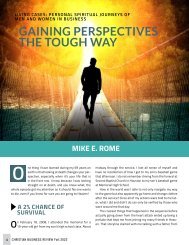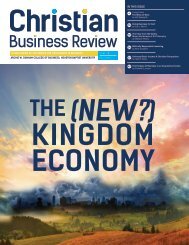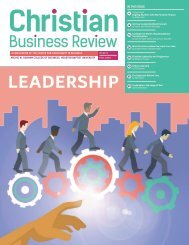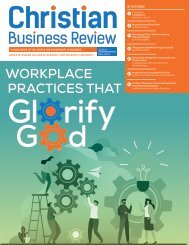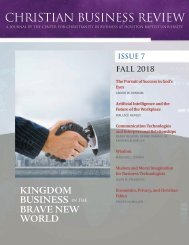Christian Business Review 2022: Pressing On Toward God's Goal
Create successful ePaper yourself
Turn your PDF publications into a flip-book with our unique Google optimized e-Paper software.
MOTIVATIONS IN FAITH-BASED ORGANIZATIONS<br />
CBR PEER-REVIEWED ARTICLES<br />
variance extracted from each construct ranged between .57<br />
to .77.<br />
Table 2 provides measurement items for each construct,<br />
Cronbach’s alpha values, means, standard deviations, and<br />
factor loadings. Table 3 provides convergent and discriminant<br />
validities for each construct and inter-construct correlations.<br />
RESULTS<br />
We used structural equation modeling (SEM) with AMOS<br />
26 to examine the hypothesized model. We employed<br />
a second-order hierarchical model because of the multidimensional<br />
nature of transformational leadership and motivation.<br />
SEM offers a simultaneous test of an entire system of<br />
variables in a hypothesized model; as a result, it can assess<br />
the extent to which the hypothesized model is consistent<br />
with the data. 43<br />
MEASUREMENT MODEL ASSESSMENT<br />
We conducted confirmatory factor analysis (CFA) to estimate<br />
the quality of the factor structure and loadings. 43 We entered<br />
the second-order variables transformational leadership and<br />
motivation (including the four dimensions of transformational<br />
leadership and the three dimensions of motivation),<br />
personal faith, perceived fit, and job satisfaction in the model.<br />
The measurement model revealed a good fit to the data<br />
(χ 2 (510) = 834.12, p < .001; CFI = .95; TLI = .94; RMSEA = .06;<br />
SRMR = .07), meeting the cutoff criteria when sample size is<br />
less than 250 and the number of measures is more than 30<br />
(i.e., χ 2 /df < 3, expected significant p-values, CFI > .92, TLI<br />
> .92, RMSEA < .08, SRMR < .09). 44 All factor loadings were<br />
equal to or greater than .68, except .47 for one item in the<br />
expectancy dimension of motivation.<br />
COMMON METHOD VARIANCE<br />
The cross-sectional survey research design and self-reported<br />
nature of our data could lead to the threat of common<br />
method variance (CMV). We took ex ante remedy strategies to<br />
reduce possible CMV, including assurance of anonymity and<br />
confidentiality, informing that there were no right or wrong<br />
answers, and encouraging that questions be answered honestly.<br />
We asked criterion variable questions (i.e., job satisfaction)<br />
first, followed by filler questions unrelated to this<br />
study and then predictor variables questions (i.e., personal<br />
faith, perceived fit, TL, and motivation). 45 We also took ex post<br />
remedy strategies by using Gaskin and Lim’s CFA approach<br />
during data analysis to test for possible CMV. 46 Specifically,<br />
we compared two CFA models, with a common latent factor<br />
added. In the first model, we set all the paths from the common<br />
latent factor to all the indicators to zero (i.e., the constrained<br />
model), while in the second model, the path coefficients<br />
are difference test revealed a significant difference<br />
between the two models (χ 2 difference = 106.06, df difference<br />
=<br />
33, p < .001; constrained model: χ 2 (510) = 834.12, p < .001;<br />
unconstrained model: χ 2 (477) = 728.06, p < .001), indicating<br />
that CMV did exist. As a result, we needed to account for the<br />
bias in the structural model. Following Gaskin and Lim’s approach,<br />
in the unconstrained CFA model, we performed data<br />
imputation, which generated adjusted scores for the five<br />
variables in the conceptual model (personal faith, perceived<br />
fit, TL, motivation, and job satisfaction).<br />
STRUCTURAL MODEL ASSESSMENT<br />
We performed SEM to determine whether the data collected<br />
support for the six hypotheses. 43 Iacobucci posits that SEM<br />
models perform well even with small samples (e.g., 50 to<br />
100). 47 Bentler and Chou (1987) propose a rule of thumb that<br />
the ratio of sample size to number of free parameters should<br />
be higher than 5:1 in order to get trustworthy parameter estimates.<br />
48 A sample size of 205 and 26 free parameters in<br />
our SEM model resulted in a ratio of 7.9:1, higher than the<br />
5:1 threshold ratio. In the structural model, in addition to the<br />
five variables in the conceptual model (now with adjusted<br />
scores), we added role (faculty and staff) and years in the<br />
organization as control variables. We did not include gender,<br />
age, and education level as controls, because previous<br />
research shows that these variables are not related to job<br />
satisfaction. 49 The results indicated that the hypothesized<br />
model fit the data well (χ 2 (2) = 3.19, p = .203; CFI = .99; TLI =<br />
.94; RMSEA = .05; SRMR = .02) (Hair et al.).44 Fig. 2 presents<br />
the overall structural model with path coefficients. The results<br />
show that neither personal faith (β = –.08, p = .272) nor<br />
the perceived fit between personal and organizational faith<br />
(β = –.07, p = .341) affects job satisfaction, thus rejecting H1<br />
and H3, respectively; however, transformational leadership<br />
is positively related to job satisfaction (β = .37, p < .001), in<br />
support of H5.<br />
Mediation effects were tested using Preacher and Hayes<br />
(2004) bootstrapping method. This method provides point<br />
CHRISTIAN BUSINESS REVIEW Fall <strong>2022</strong> 332





